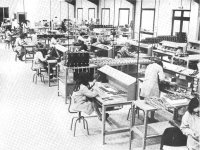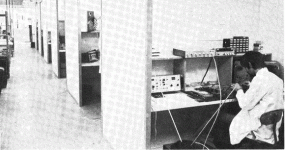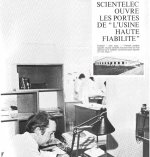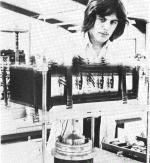He said "technical quality": a half decent mic and A/D would trounce any of the older gear. Yes, you may miss the nice cuddly distortions added by the "pro" analogue deck, but these days you can inject them back in with a piece of cheap software - in fact this is done all the time, already. The "better" engineers have a nice hardware module that adds that lovely analogue tone the old-fashioned way ...Christophe,
I don't imagine that you are saying to toss out a multichannel Neve console and replace it with a $500 Mackie desk and say you have a professional recording studio sound? You know there is much more to it than just getting new cheap consumer quality gear, it doesn't make any sense to me to think that way.
Frank
It is a very new machine. "Made on Mars". It is called PC or MAC. You can use-it as a multitrack recorder, an editing machine, an automated mixing desk, a mixing recorder. You can add a lot of effects, including nice reverberations, flange, delays, harmonizer, vocoder etc. You can even use-it to play instruments, synthetisers, piano, and simulate others, violins, drums etc...Really? Show me. I don't believe you.
All that with a bandwidth absolutely flat, a noise +distortion at the limit of your measuring instruments.
You can watch HD TV on it, sharper than on your TV set, edit photographies with 1000X more power than any film laboratory, copy all your valuable records in it and organize them. And all you need to play them is an amplifier and good enclosures.
And you can even publish on internet forums all the bad you thing about digital.
I attach 1/3 8ve noise plots of a good MM system c/f probably the quietest MC preamp in the known universe in practice.
Here's a 1/3 8ve noise plot. The B&K 2307 chart recorder has slipped by 1 tooth so 50Hz (hum) appears at 40Hz. 1dB/division
Scott, is that the one where they use a MM example and work out noise in 1/3 8ve bands? I'd appreciate a ref. I've been trying to find it since 2008.
The noise plot looks interesting but I can't figure out a reference point for comparison.
Here is Sy's calculator (based on the National app note) RIAA Noise Calculator The note, or the TI reprocessed version of the note is here: http://www.ti.com/lit/an/snva515b/snva515b.pdf
Kindhornman, i was talking about technical quality (transparency). Not 'sound'. As far we are talking about tone corrections, as an example, there is things that we cannot achieve in digital. But add some good analog corrector: done !I don't imagine that you are saying to toss out a multichannel Neve console and replace it with a $500 Mackie desk and say you have a professional recording studio sound?
Well, the big studio room/hall, the mics and the good musicians, headphones and their mixs and the ability to make a lot of things in the same time, etc. it is an other story
With the add of some DSP cards, you can approach-it very near and get a powerfull real time mixing console .
(i still prefer to work on analog console
Last edited:
Okay Christophe you had me worried for a minute there! If we are talking only about noise figures and perhaps frequency response range I'll give you that with most digital equipment, but that doesn't give you the heart and soul of the music. The recording engineer has to be as much a master of the craft as the musician, otherwise we would just have sterile boring music. I know that isn't you and I can imagine you behind the desk fattening up a vocal or adding some sheen to a cymbal.
Ortofon X5-MC doesn't show any L. Your 450mH was probably a clueless Marketing man culling numbers from a MM example by mistake.The Ortofon is (was?) the X5-MC, and those data were stated by them, as well as their description as a high-output moving coil. How they managed that L with that small R was not disclosed
I can't see Ortofon making a mistake like this. IIRC, they 'invented' the MC cartridge. IMHO, low L is one of the big advantages of MC.
My (pseudo?) transducer guru hat says it is practically impossible to make a MC cartridge with such high L unless you were really stupid.
The noise plot looks interesting but I can't figure out a reference point for comparison.
Here is Sy's calculator (based on the National app note) RIAA Noise Calculator The note, or the TI reprocessed version of the note is here: http://www.ti.com/lit/an/snva515b/snva515b.pdf
Yes, that TI piece is a significant improvement over the original bit in the back of the National Semiconductor Audio Handbook. Among other things it includes an amplifier input current noise generator, which the earlier article just mentions will make your results worse. I found it amusing that the same book had contradictory results presented in the main text, pushing a NS part for phono applications.
This the movie studio of one of my friends. 128 tracks mixing desk, 5.1 full processing, all computer based, DAW SSL Solid State Logic Soundscape.Okay Christophe you had me worried for a minute there!
They won a lot of awards.
Locaux Super Sonic Productions
As far as i'm concerned, i feel uncomfortable with all those screens, i need a real desk, and just the movie screen in the dark, to be 'in' the image and forget everything else. And to get my mix's tracks in a real physical place with real buttons. Notice, i consider myself as a poor old dinosaur of an other age, and ask indulgence.
But technically, this studio is perfect.
Last edited:
Simply 1/3 8ve noise plots.The noise plot looks interesting but I can't figure out a reference point for comparison.
- One with a MM into a good RIAA preamp.
- The other with a MC into a very low noise head amp into the same preamp.
It shows
- The MC system is quieter than the MM system
- The MC noise is pinkish so will sound less nasty and electronic than the MM noise.
Thanks for this Demian.Here is Sy's calculator (based on the National app note) RIAA Noise Calculator The note, or the TI reprocessed version of the note is here: http://www.ti.com/lit/an/snva515b/snva515b.pdf
So the article was in a book not an AN. No wonder I couldn't find it this millenium
Last edited:
"An old dinosaur"
A friend of mine had just send-me a copy of a newspaper article published in ... 1971 ?
It was my beginnings in Hifi, i was working in the R&d office of this company: Scientelec.
A shock, so many year back, makes me vibrate like the vibrating machine !!!!
and the same amp, more than 40 years later, restaured by the same friend:
https://lh6.googleusercontent.com/-Q8FpEFyMY_4/TkK-A8WYvRI/AAAAAAAATUQ/kQmNCUMs0u0/s912/P1000819.JPG
A friend of mine had just send-me a copy of a newspaper article published in ... 1971 ?
It was my beginnings in Hifi, i was working in the R&d office of this company: Scientelec.
A shock, so many year back, makes me vibrate like the vibrating machine !!!!
and the same amp, more than 40 years later, restaured by the same friend:
https://lh6.googleusercontent.com/-Q8FpEFyMY_4/TkK-A8WYvRI/AAAAAAAATUQ/kQmNCUMs0u0/s912/P1000819.JPG
An externally hosted image should be here but it was not working when we last tested it.
Attachments
Last edited:
THAT, is why we have this hideous mess in music today! God save us from fattening and sheen adding, that's why Adele is a monster to listen to ...The recording engineer has to be as much a master of the craft as the musician, otherwise we would just have sterile boring music. I know that isn't you and I can imagine you behind the desk fattening up a vocal or adding some sheen to a cymbal.
Frank
If you want a number, the contributed noise of the headamp is 0.28nV/rtHz which I believe makes it still the quietest such device in the known universe.
That equivalent to 5 Ohms. Is it transformer coupled or many paralleled transistors(or a great many paralleled tubes)?
I see that I am not the only one with a dinosaur Revox tape machine, though the one in your picture is obviously a higher end machine. Mine is just a lowly A77. Is that a picture of you with the vibrator Christophe? I still had two more years of high school in 1971 but I was already spending more time in a studio and doing concert sound here in Los Angeles. The days of moving Altec A2's and A7's and RCA Ubangi's. Brings back memories.
fas42,
If you believe that in a live show they are not adding some eq to even Adelle I would like to see that. Goes sit at the mixing console in any live show and see if there is no eq on the vocals, we aren't talking symphony orchestra's here. Just cause you use eq doesn't mean you have messed up the sound, that is crazy. And many mics are more than dropping off on the top end when you are mic'ing a drum kit, adding a little boost in the top end isn't necessarily changing the sound from the original, just helping the mic out. Now you want to talk about compressor/limiters and 1/3 octave eq now we have some problems to deal with.
If you believe that in a live show they are not adding some eq to even Adelle I would like to see that. Goes sit at the mixing console in any live show and see if there is no eq on the vocals, we aren't talking symphony orchestra's here. Just cause you use eq doesn't mean you have messed up the sound, that is crazy. And many mics are more than dropping off on the top end when you are mic'ing a drum kit, adding a little boost in the top end isn't necessarily changing the sound from the original, just helping the mic out. Now you want to talk about compressor/limiters and 1/3 octave eq now we have some problems to deal with.
No. I had long hairs, at this timeIs that a picture of you with the vibrator Christophe?
I believe i'm under the red arrow (my back), but not sure at all, i don't remember when this photo was done.
but I was already spending more time in a studio and doing concert sound here in Los Angeles.
Last edited:
How have we offended you John? I hope anything we are saying isn't an affront to you, though we have definitely steered off course..... And we even brought up Revox tape machines which couldn't be any closer to your preferred Studor tape machines. I still remember the first two track and three track Ampex tape machines I first saw in a rack mount.
Last edited:
I describe it and its history in a file at http://tech.groups.yahoo.com/group/micbuilders/files/Ricardo/. You have to join.That equivalent to 5 Ohms. Is it transformer coupled or many paralleled transistors(or a great many paralleled tubes)?
It uses a huge complement of active devices .. a grand total of 2. Alas, one of them is Unobtainium though various people have secret hoards.
And yes. It has vanishingly low THD in practice too.
There are problems building a practical transformer with equivalent performance.
Last edited:
I guess that this is about what words mean to people coming from different directions: to me, "fattening" and "adding sheen" has strong connotations of doing more than slightly altering frequency response, especially these days with very sophisticated digital sound manipulation algorithms doing all sorts of things, "distorting" sound. For people in the industry they are probably totally clear ...Just cause you use eq doesn't mean you have messed up the sound, that is crazy. And many mics are more than dropping off on the top end when you are mic'ing a drum kit, adding a little boost in the top end isn't necessarily changing the sound from the original, just helping the mic out. Now you want to talk about compressor/limiters and 1/3 octave eq now we have some problems to deal with.
Some time ago, I listened to what a "pro" box would do the cymbal sound, if various settings were played with. First, the raw sound, ahhh, nice; then the "enhancements", each one, to me, got worse and worse; some individual's fantasy of what "better" cymbals should sound like -- pretty depressing at the time ...
Frank
- Status
- Not open for further replies.
- Home
- Member Areas
- The Lounge
- John Curl's Blowtorch preamplifier part II



